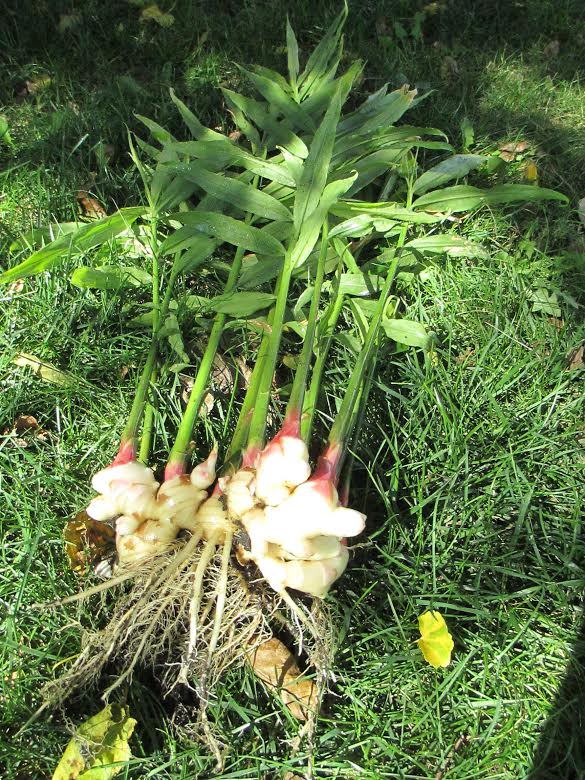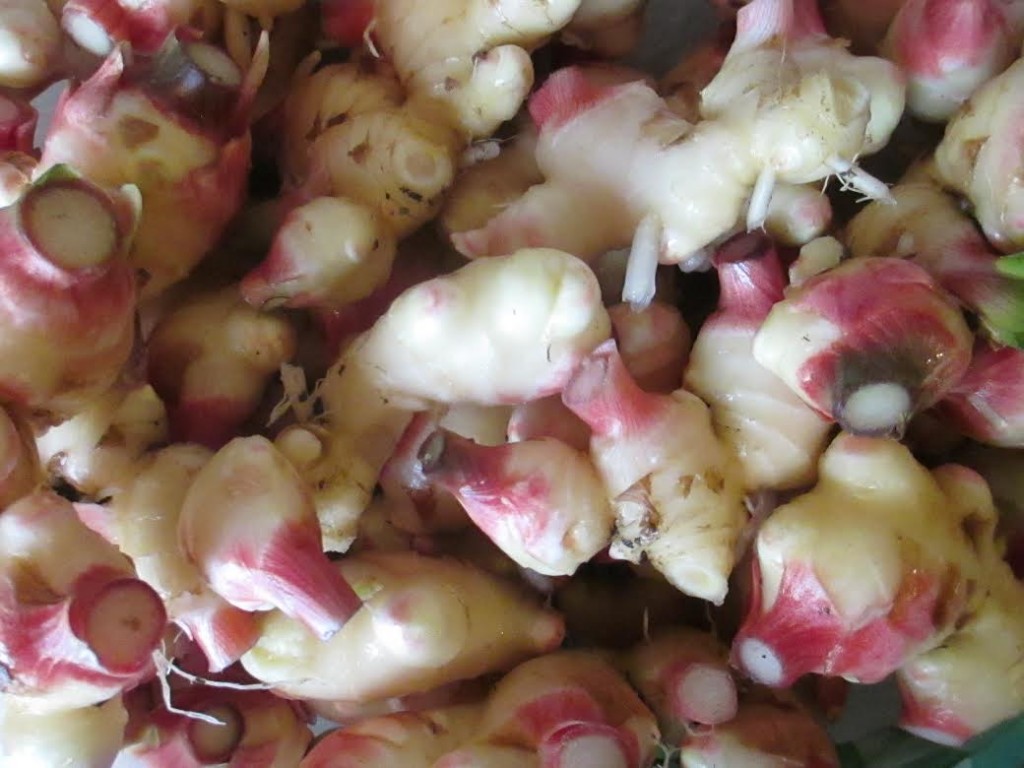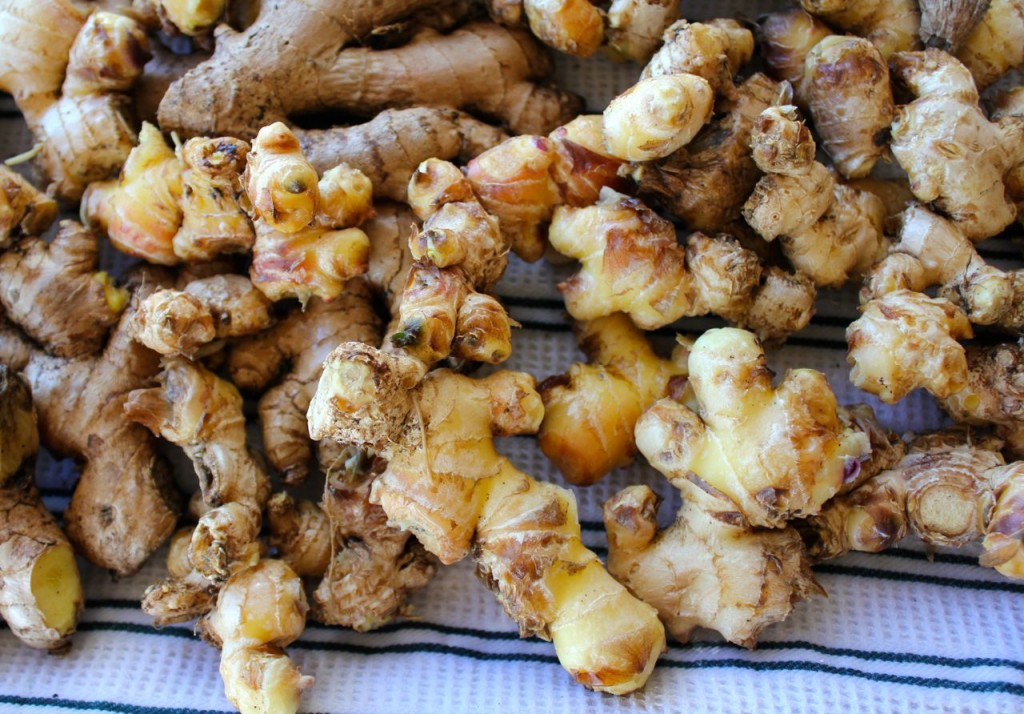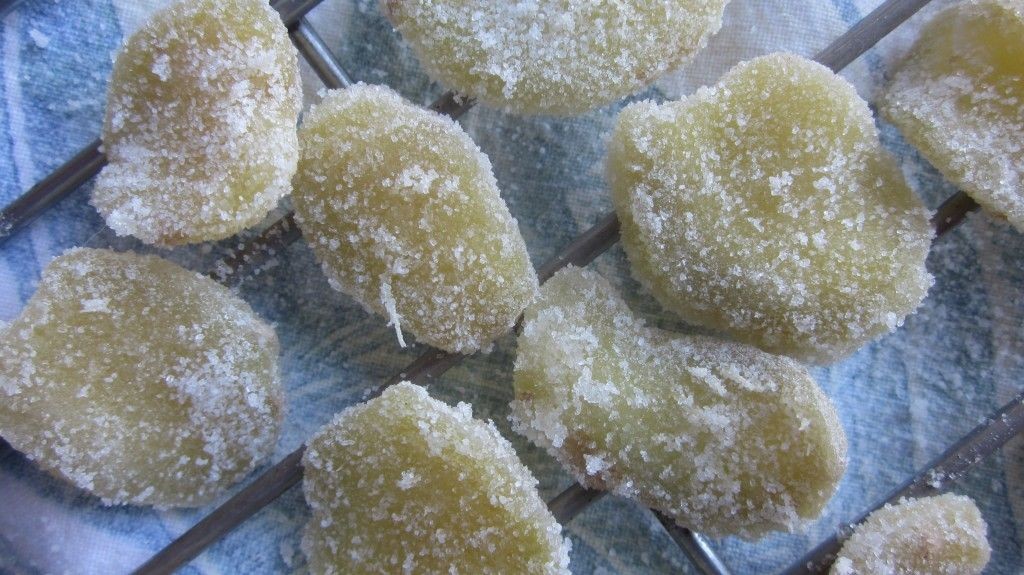Candied Ginger Root: Easy-to-make, wildly nutritious indulgence!
This popular post was updated in November 2015:

I’ve been on a bit of a ginger binge lately. I don’t know why. Maybe it’s because the days are getting shorter and colder, so I long for comfort. Perhaps it’s because I’ve been trying to lose a few pounds, so I crave intense flavors. Maybe it’s because Venus is no longer situated close to the moon in the evening sky.
I don’t know.
Ginger (Zingiber officinale) is a native plant of tropical Asia, and ginger root is the underground rhizome. The intense flavor of raw ginger, used in many Oriental recipes, is too much for many folks, for good reason: the pungent taste comes from the same family of molecules (gingerols, related to capsaicin) that cause the heat of chile peppers! But when it’s cooked or dried, some of the gingerol is converted to other compounds, though they are still sharp-tasting.
Candied or ginger root has been a favorite confection and recipe ingredient around the world for centuries, particularly in India and Southeast Asia, and at my house! Although it takes a bit of time to make it, there’s no trick to it. And if you make your own candied ginger, you can avoid the chemicals that are added to commercial crystallized ginger, and of course save quite a bit of cash in the process.

This is what ginger root looks like, freshly dug from the garden and hosed off. Photo credit Jamie Rohda
The crystallized ginger company folks don’t want you to know these two facts, you know. But now the cat is out of the proverbial bag, and you’re welcome for that!
Of course if you grow your own ginger (it’s possible, of course, in many areas to do this!) you save even more money, and will have an even better product! Score! In fact, some friends of mine who are professional gardeners grow piles of ginger root every year, to sell at their farmer’s market table. I’ve been growing a little area of ginger root in my hoop house, ever since I learned how. It’s not hard (another cat out of the bag, and you’re welcome) but it does demand a very long season. I start it inside around Christmas, for that matter. 🙂

Freshly-grown baby ginger roots.
I had this idea to add candied ginger to some zucchini bread that I was planning to make. But first I needed that pound of ginger to be candied. So I candied it. I promise you that it’s not difficult to do this, although you need to be present in the kitchen for a time. And once you’ve candied ginger, you can also take your orange peels (organic, of course, is best for this) and cut them into strips and candy them, too. You could candy lots of other things, too: grapefruit peels, almonds, pecans, lemon peels, rhubarb strips. Probably you shouldn’t candy kale or winter radishes (well–??–hmmm . . .) or cucumbers . . . or your cat, of course.
Now, a word about sugar before we proceed to my recipe. Sugar is such a controversial substance, isn’t it? We have several sugar-sensitive folks in my family, so I don’t use a lot of sugar in my cooking. I try to use our raw honey, whenever possible, so my sugar-sensitive people can enjoy what I make. But there are a few recipes that I hold dear to my heart, where nothing else but sugar will do.
For instance, my Grandma Young’s divinity recipe doesn’t set up if you try to make it with honey.
That’s experience you hear talking there. Cold, hard, never-ever-forgotten-by-your-sister-Experience. (Ever heard of “spoon-divinity?” Yup. That’s what happens when you try to substitute honey for sugar in divinity.) You could try to make candied ginger, in fact, with honey, although there are some questions about whether it’s healthy to cook honey at the high temperatures that are necessary in this recipe. Plus, in my experience, ginger cooked with honey stays soft and gooey, and I like a crunchy, chewy, sugary candied ginger, myself.
We use lots of raw honey at our place because we keep bees and we have plenty of honey, but my body doesn’t really know the difference between my beautiful raw honey and sugar. It processes them both in the same way. I love real maple syrup, too, but if I run out of that pricey stuff and start making my own syrup out of brown sugar, molasses and flavorings (which I do), my body doesn’t know the difference between that and the real stuff. Sugar is sugar, according to my body. I don’t belong to the camp that believes that White Sugar is the Devil. Of course I still prefer using the honey: it actually has some healthy compounds in it.

This is some of my homegrown ginger.
That said. Our modern Western diet has way more sugar in it than our bodies need, especially if you eats lots of processed foods. When I was a kid, my mom used to sprinkle sugar on tomato slices to get us kids to eat them. It’s the same way with food companies: a little (or a lot) of added sugar makes foods such as cereals, sodas, crackers, cookies and whatnot taste better, so we buy them. And eat them. Our bodies don’t need any sugar, in fact, as it addictive, made up of empty calories and is rather tough on our bodies for lots of reasons.
That said. Since we eat very little processed food, I belong to the camp that believes that a bit of sugar now and then won’t hurt you, as long as it is part of a very healthy diet. If I’m feeding my family big piles of veg from my garden, our own pastured chickens, and lots of good fruit, then if we have a bit of sugar for dessert, I don’t lose sleep over it. Are you with me?
Now here’s the kicker. I can eat an awful lot of this candied ginger, if I allow myself the indulgence. It is so tasty. It’s so spicy and chewy and so . . . . so addicting. My consolation to myself is that it’s ginger root, after all, and ginger root is actually quite packed with nutrients!
It’s well documented that ginger relieves indigestion, nausea, colic, gas, heartburn, morning sickness, and motion sickness. In addition, ginger seems to protect against ulcers, is helpful against internal parasites, and may even ease acid reflux. Old timers also knew that ginger was good for coughs. Further, it warms you when you are chilled and paradoxically, helps reduce a fever. Ginger compresses relieve sore muscles, stomach cramps, and swollen glands. This is great stuff, folks!
Recently, much medical research, particularly in Europe and Japan, has documented the therapeutic effects of the ginger rhizome, which contains 400+ compounds including enzymes and antioxidants. Some of the studies showed how ginger mediates healing and immunity by reducing abnormal inflammation and clotting. Also, ginger seems to have anti-cancer properties, blocking carcinogens, and it tones the circulatory system, suggesting that it could reduce heart disease. Recent Danish research showed that long-term ginger consumption might reduce arthritic conditions.
So, eat your ginger, Gentle Readers! It’s awfully good … and just good for you, too!
Now . . . on to the recipe!
- 1/2 pound gingerroot, peeled (try using a spoon, it works well!) and sliced very thin
- 2 1/4 cups sugar
- melted dark chocolate, confectioners sugar, and more sugar for dipping (optional)
- First, peel the gingerroot, and slice it very thin.
- Bring 2 cups of water and 2 cups of sugar to a simmer and add ginger.
- Cook until ginger is tender, about 45 minutes.
- Strain ginger, but save the liquid: it makes a wonderful syrup on ice cream, in drinks, or whatever!
- Spread ginger out on rack set on a pan, and allow to dry, but don’t rush it: allow at least 5 hours. Reserve syrup that drips on the pan, we aren’t wasting any of this gingery goodness!
- Put additional sugar in bowl and toss the dried ginger slices until they are completely coated. I leave the ginger in the bowl of sugar for an hour or two, to further dry them.
- You’re finished! Don’t toss the sugar that is left in the bowl–you can use it in your coffee or tea, or sprinkle it on top of cookies for a sweet gingery topping! Your candied ginger will keep well in a covered container for 2 weeks or more, but I’ll bet that it won’t last that long . . .
Here are a couple more handy tips for you: take the syrup from the cooked ginger, chill it, add ice cubes and club soda to taste, and ta-daaa! You’ve just made the best ginger ale you’ve ever tasted! Now aren’t you clever? 🙂

candied ginger: yum!
Happy ginger candy-making, you!
*hugs*
- Celebratory Coconut Cupcakes with White Chocolate Cream Cheese Frosting
- 14 Things I Love About October


I love candied ginger… never thought to make it at home, and this sounds easy enough!
Interesting facts you shared, too. Ginger definitely has a kick to it, so it makes sense that it shares some things in common with chile peppers!
Amy, yes, even the candied version has a kick to it!
Thanks for sharing the recipe. Hope to try it out.
I hope you do!
I am a ginger nut, I love it in so many different ways. Actually start my day with a cup of lemon tea to which I have added ginger and honey. That is an every day thing. I have been making candied ginger for a few years now, and often wrap it in a fancy wrapper and give it as gifts. I must admit I have not been dipping any in dark chocolate, but that oversite is about to end. Nice article.
I adore ginger, I love adding it to curries and other asian food. I also adore it in tea, I am not sure how I would react to such sweetness but I have just been told by a certain person that she would quite like some made for Christmas – so this will be my opportunity to give it a whirl !
This is my Christmas treat!
We enjoy fresh ginger in Chinese cooking. I forgot about it being good for coughs. This is another one that has been pinned – someone may be getting this as a holiday gift.
It would be a dandy gift, Alana, put into a jar with a pretty bit of fabric and ribbon and tag. Great idea! I’ve thought about doing this with candied orange peel, but I can’t always find organic oranges.
Hello, I am cooking up your Candied Ginger 2day, smells awesome. You mentioned Oranges too, could they be added to the ginger bath?…I’ve started the ginger on stovetop then moved into slow cooker, I think a couple of hours on High should b Ok…what’s are you thoughts on this?
Thanks kindly..
Yes, I think strips of orange peel would work well with your ginger, though the flavors may mix. And your experiment with the slow cooker intrigues me. I’ve never tried it that way. Please let me know if it worked well!
I’ve just eaten some candied ginger, sent by my writing partner from Germany. I rarely eat it–it’s SO HOT! The reason I did this morning is because of a headache. I rarely get a headache, but when I do, candied ginger works. I think it shocks the body, which has to choose which pain to concentrate on. The sting and fire in the mouth wins. Your recipe sounds easy to do. I’ll give it a try.
So Francene, did it help with your headache?
OH MY! Thank you, thank you! I’m fixin’ to dig up my ginger and am so excited I found your recipe! Ohhhh…I could eat this stuff till’ my nose runs 🙂 When I go and have sushi with my daughter, I get embarassed because I alway order three servings of the pickled ginger and will eat it all in one sitting. Never knew it was this easy. Tks again!
Oh yes, it’s so easy and so delicious!
love the recipe! thank you I have been relying on commercial candied ginger to help with my acid refulx. question: do I have to do the final coating of sugar, my doctor recommened that I avoid sugar.
Karen,
NO you do not have to do that final coating of sugar–it makes it a lot prettier, and not as sticky, but it’s not necessary.
Pingback: candied ginger for acid reflux - Food Recipe
Pingback: crystallized ginger unhealthy - Food Recipe
I don’t know if you can answer this, but I bought some candied ginger about a month ago (and probably haven’t been storing it right). Now there are suddenly wet spots in the ginger. Do you know why this happened and if it’s still safe to eat?
Monica, you’re right–I really can’t answer that. However, it’s very unusual that candied ginger would suddenly grow damp–I think I would take it back to the store where you bought it and ask them about it. Probably the key is in your line “probably haven’t been storing it right.” If the ginger has been uncovered and in a moist place (i.e. refrigerator?) it probably would pick up moisture from the other moist things in there. That’s my guess!
love it! Tyvm! I have an asian background. Instead of using mayonaisse, we ground peeled ginger, add salt, some scoops of hot vegetable oil to kill it. Let it cool down and add some chopped spring onions. It is quite delicious, and is used to season boiled hen, chicken, meats… we add a little bit on stir fries or on plain boiled rice to serve.
Thank you so much for this! This sauce sounds like a wonderful thing to try out in my own kitchen! Thanks for sharing.